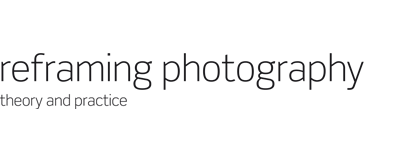Altering Human Vision
Human vision is continually mediated. Corrective lenses and sunglasses alter all visual data. Windows and doorways frame and restrict our view, lighting amplifies focus and architectural plans order all visual elements. These devices operate as photographic viewfinders, designating importance through visual hierarchies and simplifying our visual world. Some of these tools are manufactured: the size and shape of a television screen, the shape of a camera’s viewfinder, the span of a pair of spectacles, the conventions of landscaping that dictate intervals for spacing trees -- all are determined for us. Artists invent other viewing devices in order to reframe the visual world in idiosyncratic and site-specific ways.
Windows of an automobile work as viewfinders that structure and limit the visual stimuli we see from the confined space of the car. Because car bodies are fairly high, our orientation in the vehicle places us at approximately the same height as when we stand. That familiar vantage point helps make sense of our view when driving at high speeds. In the Modified Auto Viewer, artist Julia Farina adapted a car seat by fastening a cushion to the middle of the car door. With her head resting on this support, she wears an eyepiece, a combination of goggles and blinders, which block peripheral vision and focus her eyesight upwards. Julia is repositioned at such an angle that she can no longer see the ground. Wearing the viewer with the car in motion, she initially attempted to orient herself with the new upside-down view of treetops, sky and an occasional roof. Unable to navigate, she gradually stopped trying to identify her environment and began to experience visual phenomenon without preconceptions.
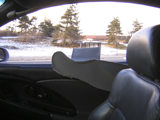
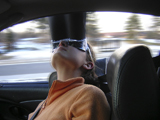
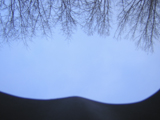
photos: Julia Farina. 1)The headrest of the viewing device attaches to the cart seat and door, instructing the passenger on how to shift their body to the new viewing mode. 2) Viewing device in use while car is moving. 3) Simulation of the new field of vision.
Corrective Lenses
Eyeglasses correct nearsighted vision, also referred to as myopia, and/or farsighted vision, called hypermetropia. With myopia, the length of the eyeball is too long or the cornea has too much curvature, causing distant objects to blur while near objects remain in focus. This elongated eyeball is caused by sustained visual attention on the small and the close. In Our Own Devices, Edward Tenner references studies of Alaskan Eskimo families in the 1960s. The results showed that a 2 percent myopia rate in adults with traditional lifestyles increased to a 50 percent rate in their schooled children. Fortunately, corrective concave lenses compensate for myopia by refocusing the light directly onto the retina. Conversely, with hypermetropia, the eyeball is too short or the cornea does not have enough curvature. As a result, near objects will appear blurred while far objects remain sharp and focused. Corrective convex lenses help to refocus the light directly onto the retina.
Contact lenses work in the same way as glasses, by refocusing light directly onto the retina. However, they are customized to fit directly against the eye. Consequently, contacts also address peripheral vision. Their shortcoming: they restrict oxygen to the cornea if worn for long periods of time (as opposed to glasses which do not). Recent developments in lens technology introduce more silicone (which is similar to oxygen) and more H2O into the lenses so that users can wear them for longer periods of time.
In some instances, spectacles limit vision. Sunglasses and sun-blocking contact lenses filter out harmful ultraviolet light that can contribute to the development of cataracts and retinal problems. The Dribble Master™ Basketball Goggles reduce angle of view by blocking the athlete’s lower vision. When handling the ball, looking down at a dribbling hand wastes precious vision. The goggles are meant as a training tool to teach correct ways of seeing on the court: they force the athlete to dribble without looking at the ball.
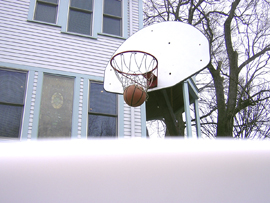
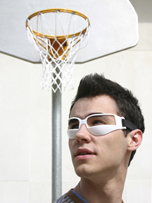
photo left: Julia Farina. View through Dribble Master™ Basketball Goggles.
photo right: Rebekah Modrak. Dribble Master™ Basketball Goggles.
Adorning the face, eyeglasses affect vision and indicate character. In Our Own Devices, Tenner cites the ways spectacles have alternately raised or crippled the status of their wearers. During the Renaissance, glasses were rare enough to be seen as signs of a person's station in life or an indication of their ample education. United States President Theodore Roosevelt went into battle in the Spanish American War sporting a pair of pince-nez and in his portrait on Mount Rushmore he wears them still. In the early twentieth century, Hitler read his speeches from large-print texts rather than wear spectacles that might reveal some corporeal weakness. Artists and celebrities, such as Buster Keaton and Elton John, wear them as audacious symbols of fashion or strong personality. Today, eyewear continues to transform wearers, often by transforming the eye itself. Share Generate’s Nadesicco Black contact lenses allow girls to aspire to the cuteness of large-eyed anime characters by darkening the iris so that it merges with the pupil into a giant pool of black.
Binoculars
If you do not have access to a subject (a bashful monkey or a guarded presidential rally), binoculars allow you to get a closer view. Their magnification is minimal enough that they can still be hand-held and relatively compact.
Magnification or power
Binoculars are described with a two-number figure, such as 8 x 40. The first number is the power of magnification (in this case, the binoculars will magnify the subject 8 times). Higher magnification does not always result in easier visibility as greater magnification allows less light in, narrows the field of view and is less steady an image (camera shakes are more visible).
Brightness
The second number in a figure such as 8 x 40 is the diameter in millimeters of the binocular lens. The larger the number, the more light allowed through the lens and the brighter and more detailed the image will be. When choosing the lens mm, consider what the lighting conditions will be like and your distance from the subject. If looking through the binoculars in bright sun, a 30mm lens will be fine; at dusk, in shadow or in other dim-light conditions, a 40mm or 50mm lens will be better. If the subject is fairly close (say 50 feet), 35mm will do; at greater distances, a 40mm or 50mm will provide greater detail and color.
Brightness is also affected by lens coatings; manufacturers coat some or all of the glass surfaces to increase the amount of light that will pass through the binoculars. Binoculars with “fully coated” or “multi-coated” surfaces will increase contrast and brightness and eliminate glare and light reflection.
Field of view
The field of view is the width of the image as you look through the binoculars. Manufacturers generally describe field of view with a figure such as “357 ft. at 1000 yd.”. This means that when studying President Obama's dog from 1000 yards, you will be able to see a width of 357 feet. A roaming soccer ball demands a greater field of view to more easily scan the large area of turf. A fixed subject (an opera singer who does not move) can be easily located and followed with a narrow field of view. Magnification also affects field of view: the greater the magnification, the smaller the field of view.
Focus
Most binoculars are center-focusing; they have a wheel, knob or lever that focuses both barrels at the same time, while also allowing you to adjust one barrel at a time to make up for differences between your eyes. Some focusing wheels are highly sensitive and need only be turned slightly. This is helpful if you need to continually refocus on a moving or changing subject. Other focusing wheels require several rotations; time that could cost you to lose the subject. If the subject is relatively still, and can be focused once and then never again, the focusing ease and speed is not important. The other issue with focus is distance. Most binoculars can focus as close as 5 or 6 feet.
User considerations
These factors involve the ease of holding and wearing the binoculars. Eye comfort is important. Manufacturers provide a measurement describing the binocular’s eye relief, the distance from the eyepiece to the surface of the eye. Around 10mm is comfortable for most people. If wearing glasses, 15mm allows extra room. For wider- or closer-set eyes, the ability to adjust the distance between the barrels of the binoculars helps to customize the eyepiece. The shape of the binoculars is also important to consider in relation to your hand size and the finger length. The instrument should be easy to hold and adjust. The weight should be manageable, especially if wearing them for long periods of time. If using the binoculars in varied weather conditions and throughout terrains where they could be dropped or knocked around, consider water-resistance and durability.
Camera-Binoculars
Another breed of cameras fortifies binoculars with digital recording capabilities. These binoculars have the same features described in Binoculars, but also have built-in digital cameras that can be switched on independently to record digital photos or streaming video. Images can be transferred to a computer or viewed on a television monitor.
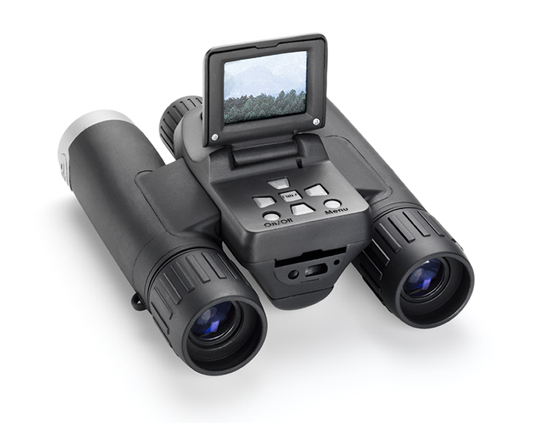
photo: Courtesy of Bushnell. Bushnell Sync Focus ImageView camera-binoculars.
With this equipment, there is often a difference between the magnification power of the digital sensor and the binoculars. While the binocular brings the viewer from the nosebleed seats to the orchestra pit, the camera lens may only take you a few rows ahead. The strength of the camera binoculars lies in the hybrid nature of the device.
Bushnell’s Instant Replay or Flashback feature allows user to shoot a digital movie and, by pressing the Instant Replay button, discard all the footage except the last 10 or 20 seconds. The feature is designed for activities that involve waiting out an unpredictable subject -- scanning through the trees in search of a bird, following your child’s soccer maneuvers in pursuit of a precious goal. Instant Replay allows viewers to discard all the so-called insignificant non-events and save only those of consequence. The camera-binocular’s possibilities are considerable for artists who strive to capture distant events, decisive moments or the seconds in between.
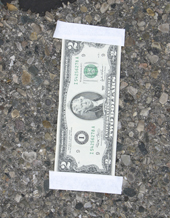
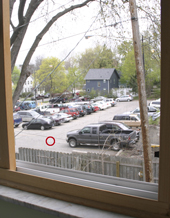
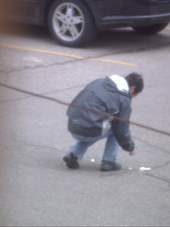 photos: R. Modrak. After having my first child, I spent a lot of time while nursing staring out of my window into the parking lot below and exercising my memory by tracking which people belonged to which cars. To further my interest in the lot, I experimented with the camera-binoculars by taping money in place and then tracking responses. This guy picking up the bill (third picture) is the ninth person who saw it, but the first to pick it up.
photos: R. Modrak. After having my first child, I spent a lot of time while nursing staring out of my window into the parking lot below and exercising my memory by tracking which people belonged to which cars. To further my interest in the lot, I experimented with the camera-binoculars by taping money in place and then tracking responses. This guy picking up the bill (third picture) is the ninth person who saw it, but the first to pick it up.
Night Vision Devices
Night vision devices operate in different ways. At the most basic, they amplify or multiple existing light, up to a thousand times. The amplified light hits a phosphor screen, which reacts by creating pools of green glowing light, visible to the human eye. While these viewers only function in low light conditions, almost all situations do have some light (pitch black darkness is very rare).
Telescopes
A telescope is usually a higher-powered binocular, with only one barrel. While binoculars generally magnify a scene from 8 to 12 times, the average telescope magnifies the view 200 times. Because their magnification is so great, most telescopes are somewhat bulky and must be stabilized with a tripod. While telescopes can be used in a variety of capacities and are an underutilized source of imagery for artists, most guides and reviews describe telescopes as tools for studying the stars. In any case, the features to consider are similar to binoculars. The most important choice is the diameter of the telescope’s refractor: brighter scenes need a smaller telescope aperture (70mm diameters for brighter constellations; 100mm diameters for fainter, dimmer galaxies).
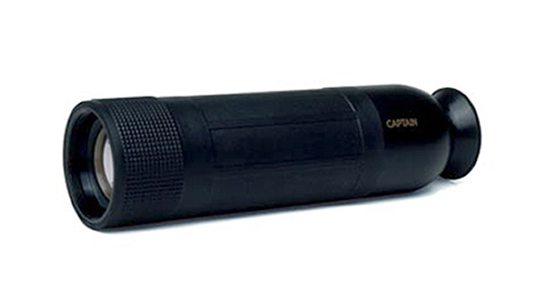 photo: Courtesy of www.lomography.com. The Captain Telescope’s magnification (14x) is slight for a telescope but allows it to be handheld.
photo: Courtesy of www.lomography.com. The Captain Telescope’s magnification (14x) is slight for a telescope but allows it to be handheld.
